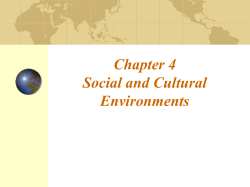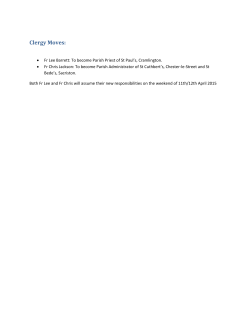
Lee. EKO3 2015 1 Culture and Classification
Lee. EKO3 2015 1 Culture and Classification: Ethical Issues of Adopting Global Classification Standards to Local Environments Wan-Chen Lee, Information School, University of Washington leew23@uw.edu Abstract: This paper looks at ethical issues that arise from adopting standardized classifications. Research affirms cultural influences in classifications. However, there are various conceptions of culture in knowledge organization and anthropology. In this paper, we propose a definition of culture based on comparing and aggregating discussions from the two bodies of literature. This definition points to areas of further research concerning cultural ethics and knowledge organization. Thinkers in knowledge organization have shown how cultural context affects classification. For example, López-Huertas (2008, 2013) observes cultural affects in terminology, concept identification and naming, categorization, focus of themes, and citation order in the same subject domain. Beghtol (1986) sees classifications as cultural artifacts mirroring societal trends in her discussion about cultural warrant in classification theory. Classificationists working in different cultures make different decisions about what is included and excluded. This results in ethical challenges concerning representation and prioritization. Olson (1999) considers classifications efficient in representing and reinforcing dominant cultures by representing the perspective conforming to its embedded culture. Standardized controlled vocabularies like LCSH are widely adopted. With adoption, the mainstream perspectives are also adopted (Olson, 2000). However, the mainstream perspective may not represent the whole of lived experience of the population. The exclusion of non-mainstream perspectives is an ethical challenge. 1 Lee. EKO3 2015 2 Mai (2013) criticizes the general assumptions made about classification’s neutrality and the universality of knowledge. This complements Furner’s (2007) critical race theory analysis of the DDC. Mai advocates for the development of ethical classification which values culture and context. Through developing culturally sensitive classification models, librarians can provide more equitable and ethical access to information. Before diving deeper into discussions on designing a culturally sensitive classification model, it is critical to clarify how culture is defined in the literature in both knowledge organization and anthropology, the discipline that takes culture as its object of study. The review is organized into different families of definitions. Culture has been defined as: (1) Nationality or geographic region (López-Huertas, 2008, 2013; Steinwachs, 1999) (2) Context in which concepts are interpreted (Taheri, Shahrestani, & Nezhad, 2014), and in which symbols can be thickly described (Geertz, 1973). (3) Collective phenomenon which can be seen as “software of the mind” (Hofstede, 1994) or psychological structures (Goodenough, 1971), including accepted patterns of thinking, feeling, believing, and potential behavior (Hofstede, 1994; Kluckhohn, 1944; Menou, 1982). People acquire the collective phenomenon from the society in order to adjust to environment, and be accepted by other members (Kluckhohn, 1944; Steinwachs, 1999; Tylor, 1958). (4) Man-made part of human environment: which can be divided into: objective/material culture, and subjective/non-material culture. The former includes artifacts and observable patterns of human activity. The latter consists of code of signs and meanings which shape people’s perception of the world, such as values, stereotypes, and attitudes (Menou, 1982). (5) System of ranked values: different cultures are likely to share some values (e.g. weight control), but rank them differently (Everett, 2012). We propose a definition of culture based on the definitions above. For our purposes, culture is a cognitive framework constructed by a community. The framework influences 2 Lee. EKO3 2015 3 how people within the community perceive the world. Some characteristics of culture include: (1) Generational: Younger generation internalizes culture via learning and conforming to social norms (Kluckhohn, 1944; Steinwachs, 1999; Tylor, 1958). (2) Dynamic: The interpretation, manifestation, and popularity of a culture evolves over time. (3) Co-existing: Different cultures co-exist not only in the world (Olson, 2000), but often within one person. We then present, in the paper, a discussion about ethics and culture in knowledge organization. Culture influences the way we make sense of the world. It also affects how we classify, including how we prioritize, structure, arrange, and represent concepts. Designers of classifications, we assume, have to adopt at least one culture, likely the dominant one or set, as the basis of a series of decisions required for classification. Integrating cultural elements into a classification may make it more intuitive to users conforming to the culture(s) from which the classification originates. However, users who do not share the culture(s) embedded in the classification could face a sense-making gap. In addition, the trend of adopting classification standards, copy cataloging, and cooperation across cultures complicate the issue. Tension between standardization and localization of classifications is not only about cost and policy, but because of culture, is also an ethical issue. References: Begthol, C. (1986). Semantic validity: concepts of warrant in bibliographic classification systems. Library Resources and Technical Services, 30(2), 109-125. Everett, D. (2012). Language: the cultural tool. London: Profile. Furner, J. (2007). Dewey deracialized: A critical race-theoretic perspective. Knowledge Organization, 34(3), 144-168. 3 Lee. EKO3 2015 4 Geertz, C. (1973). The Interpretation of Cultures: Selected Essays. New York: Basic Books. Goodenough, W. H. (1971). Culture, Language, and Society. McCaleb Module in Anthropology. Reading, Mass: Addison-Wesley. Hofstede, G. (1994). Cultures and Organizations – Software of the Mind. HarperCollins, London. Kluckhohn, C. (1944). Mirror for Man: the Relation of Anthropology to Modern Life. New York: Whittlesey House. López-Huertas, M. J. (2008). Cultural impact on knowledge representation and organization in a subject domain. Xth International ISKO Conference. Montreal, (pp.340-346). Würzburg: Ergon. López-Huertas, M. J. (2013). Transcultural categorization in contextualized domains. Information Research, 18(3) paper C16. Mai, J. -E. (2013). Ethics, values and morality in contemporary library classifications. Knowledge Organization, 40(4), 242-253. Menou, M. (1982). Cultural barriers to the international transfer of information. Information Proceedings and Management, 19(3), 121-129. Olson, H. (1999). Exclusivity, teleology and hierarchy: our Aristotelian legacy. Knowledge Organization, 26(2), 65-73. Olson, H. (2000). Difference, culture and change: the untapped potential of LCSH. Cataloging & Classification Quarterly, 29(1/2), 53-71. 4 Lee. EKO3 2015 5 Steinwachs, K. (1999). Information and culture – the impact of national culture on information processes, Journal of Information Studies, 25(3), 193-204. Taheri, S. M., Shahrestani, Z., & Nezhad, M. H. Y. (2014, May 19-22). Switching Languages and the National Content Consortiums: An Overview on the Challenges of Designing an Iranian Model. In W. Babik (Ed.), Knowledge Organization in the 21st Century: Between Historical Patterns and Future Prospects, Kraków, Poland, (pp. 367-373). Würzburg: Ergon-Verlag. Tylor, E. B. (1958). Primitive Culture. New York: J. P. Putnam’s Sons. v.1, p.1. 5
© Copyright 2025









